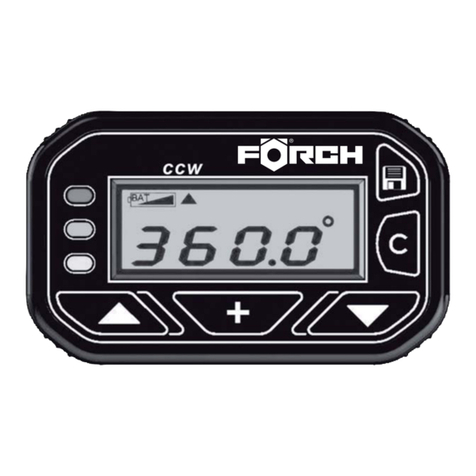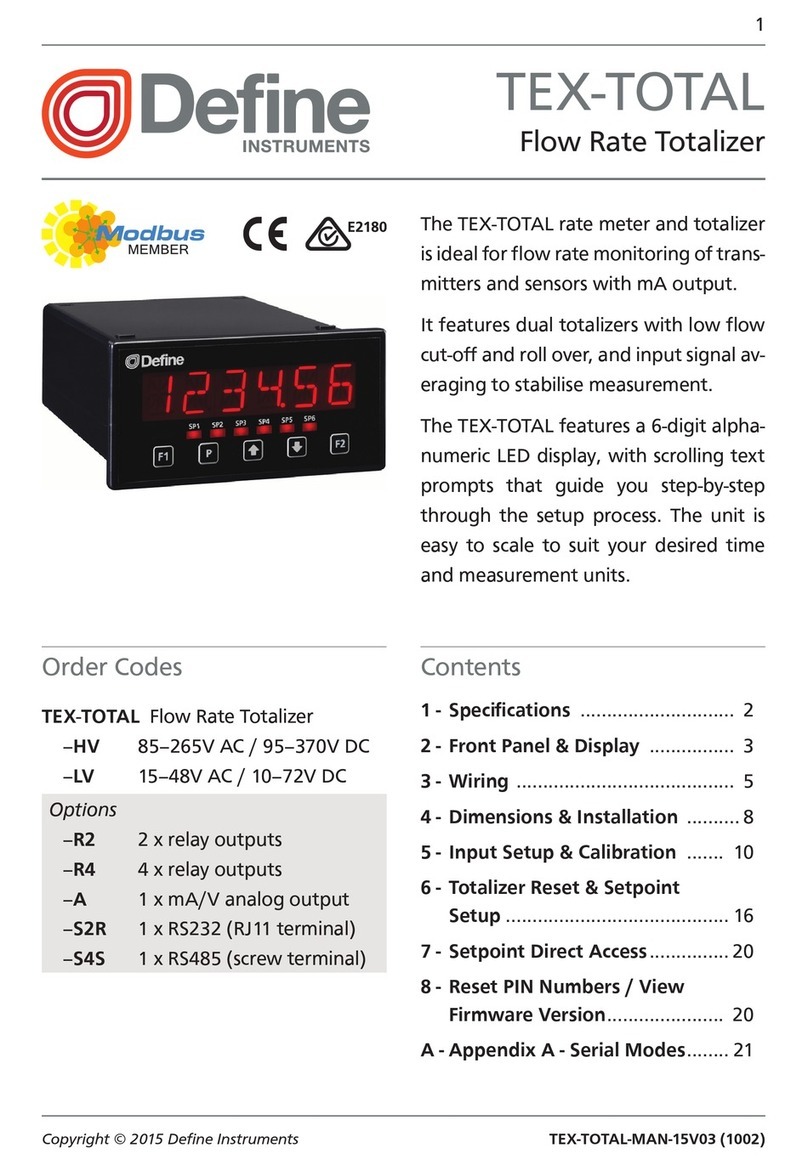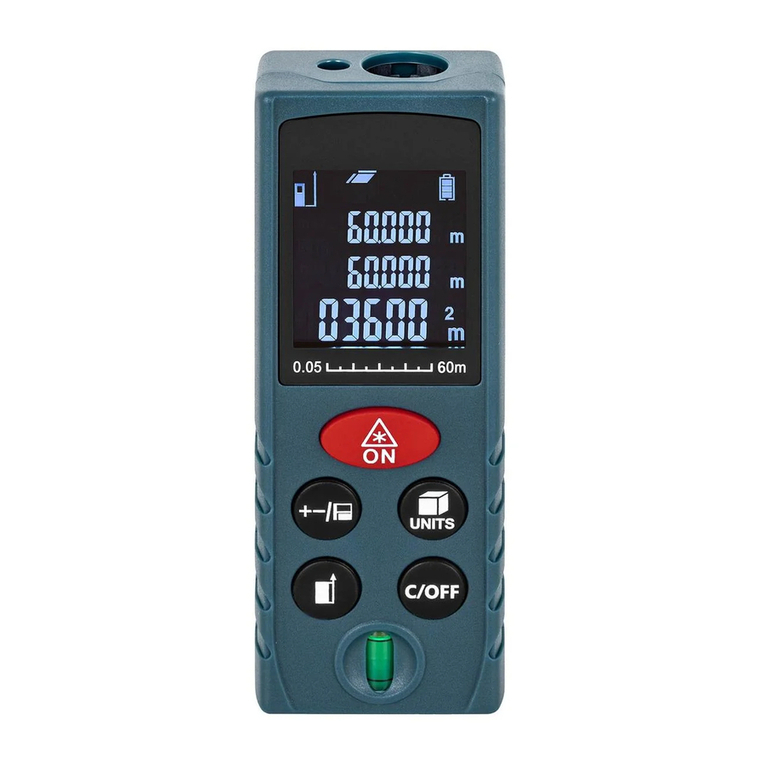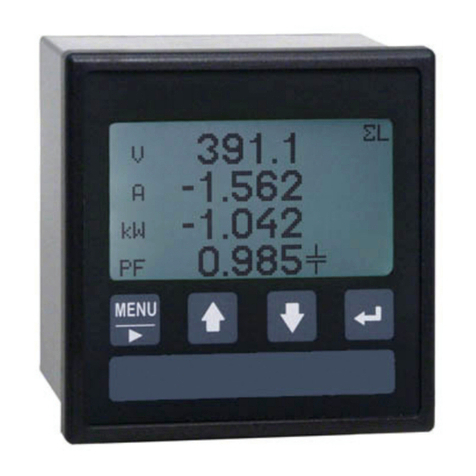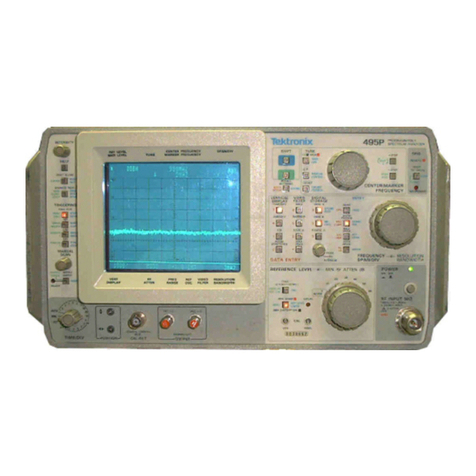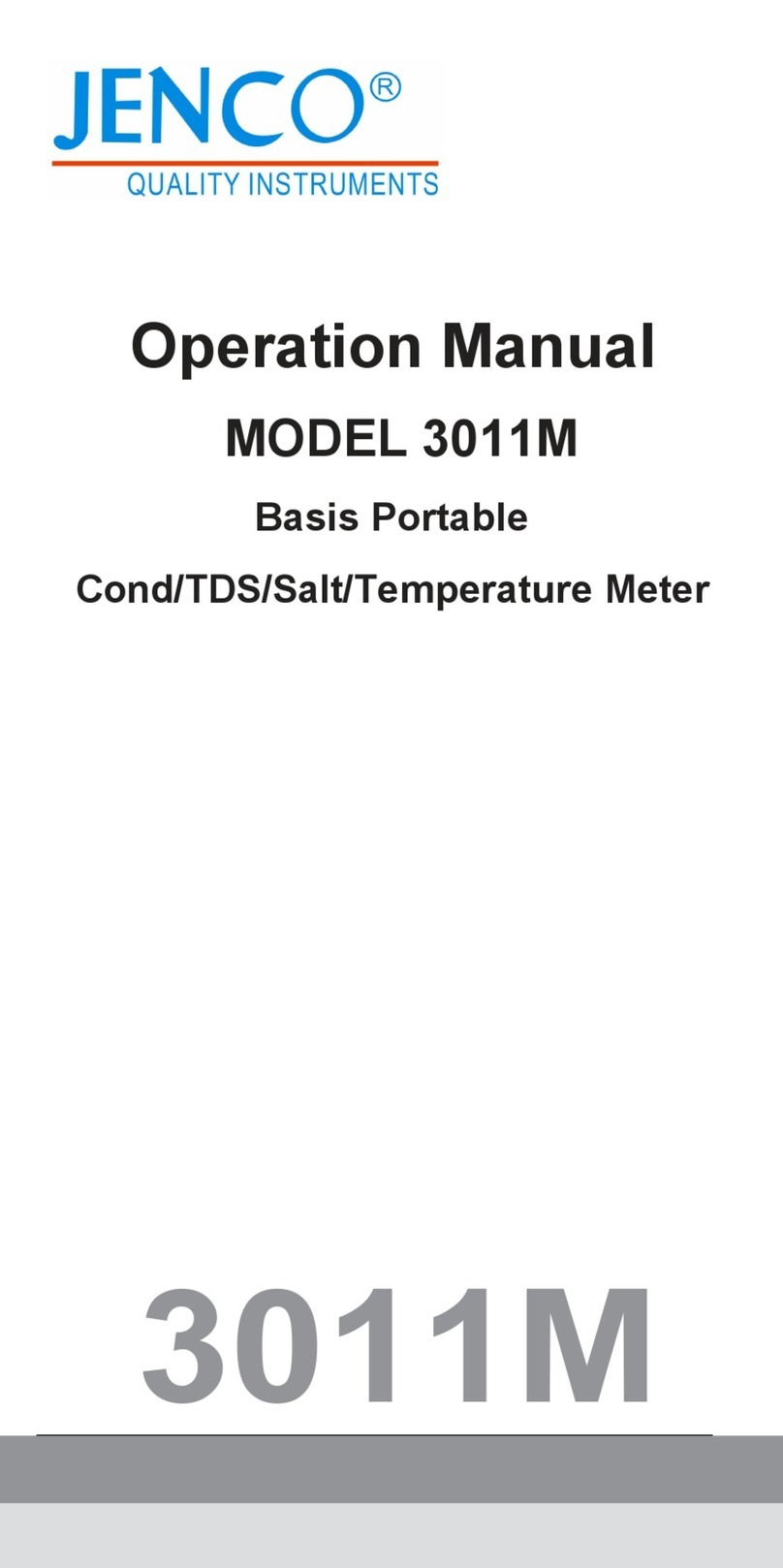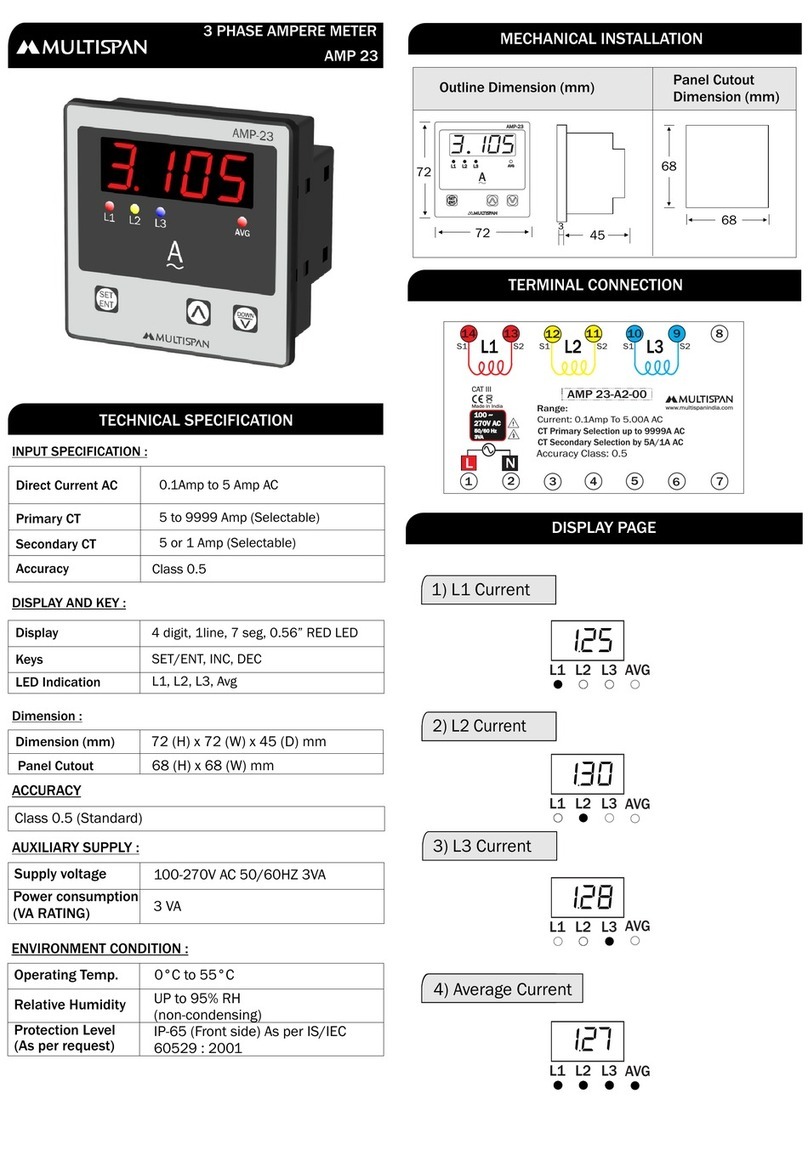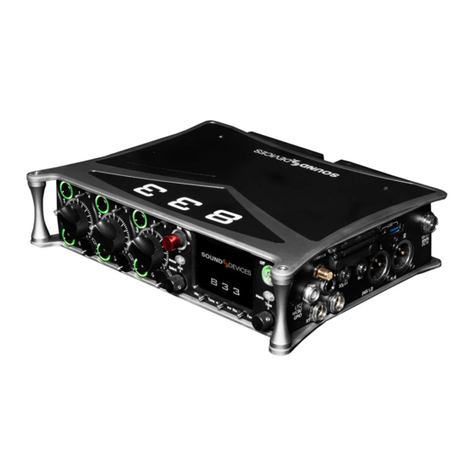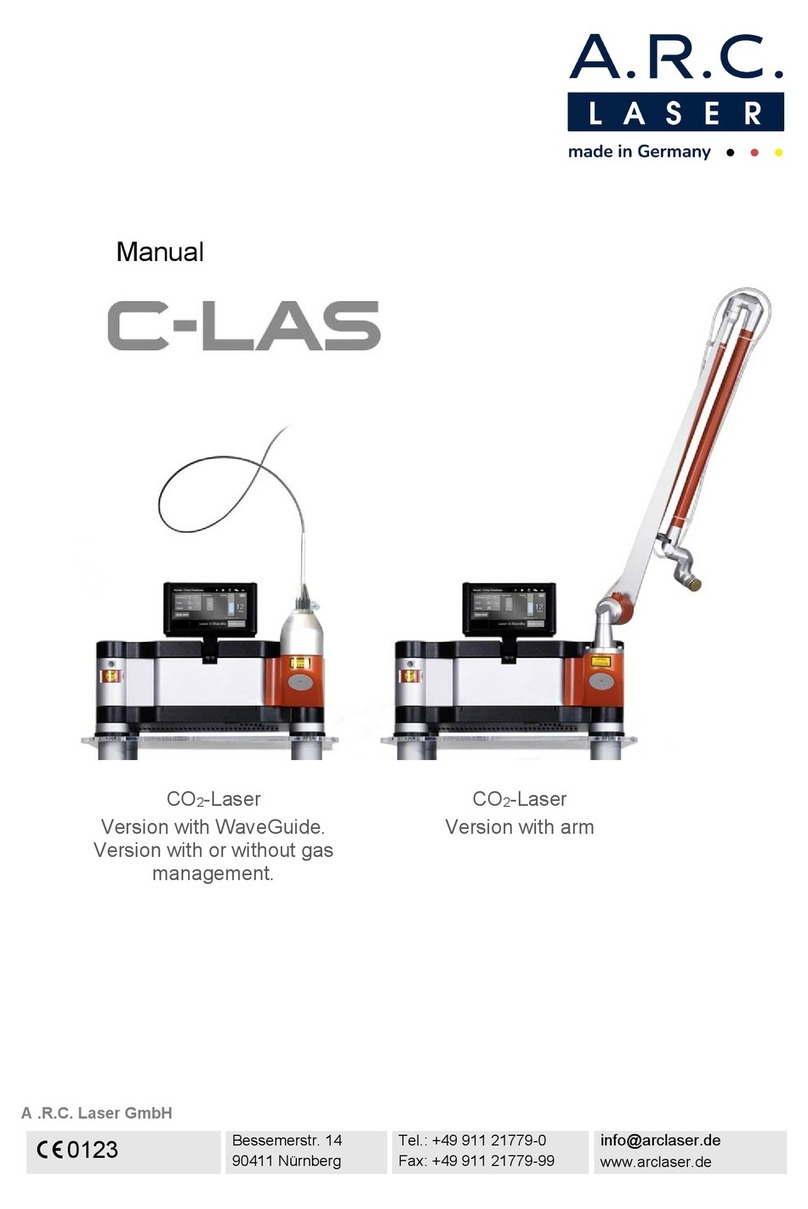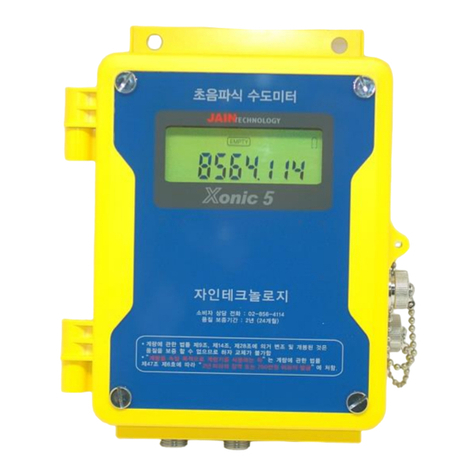Industrial Fiber Optics 45-545A User manual

Digital Laser
Power Meter
User’s Guide
In d u s t r I a l FI b e r Op t I c s
Model Numbers:
45-545A

*
Copyright © 2009
by Industrial Fiber Optics, Inc.
Revision D
Printed in the United States of America
* * *
All rights reserved. No part of this publication may be reproduced,
stored in a retrieval system, or transmitted in any form or by any means
(electronic, mechanical, photocopying, recording, or otherwise)
without prior written permission from Industrial Fiber Optics.
* * * * *

– i –
INTRODUCTION
This manual provides information about the Digital Laser Power Meter
(45-545A) that formerly was manufactured by Metrologic, Inc. It contains all the
information needed to assemble and set up the Digital Laser Power Meter, even
if you are a novice to optical technology. Please read the manual carefully before
operating the Digital Laser Power Meter.
As soon as you receive this Digital Laser Power Meter inspect it and the
shipping container for damage. If any damage is found, immediately refer to the
section of this manual entitled Shipment Damage Claims.
Industrial Fiber Optics makes every effort to incorporate state-of-the-art tech-
nology, highest quality and dependability in its products. We constantly explore
new ideas and products to best serve the rapidly expanding needs of industry
and education. We encourage comments that you may have about our products,
and we welcome the opportunity to discuss new ideas that may better serve
your needs. For more information about our company and products refer to http//
www.i-beroptics.com on the Worldwide Web.
Thank you for selecting this Industrial Fiber Optics product. We hope it
meets your expectations and provides many hours of productive activity.
Sincerely,
The Industrial Fiber Optics Team

– ii –

– iii –
TABLE OF CONTENTS
Introduction……………………….................…….....…………..…… i
GENERAL…………................….............................……..…...…….. 1
SAFETY & OPERATING PRECAUTIONS…..........................……. 2
LASER CLASSIFICATIONS............................................................ 3
THE DIGITAL LASER POWER METER.......................................... 4
BATTERY INSTALLATION.............................................................. 5
MEASURING: STANDARD MODE................................................. 6
MEASURING: PEAK/HOLD MODE................................................ 7
MEASURING: RATIOMETRIC MODE............................................. 8
OUTPUT........................................................................................... 9
RECALIBRATION............................................................................ 9
SPECIFICATIONS............................................................................ 10
TROUBLESHOOTING..................................................................... 10
WARRANTY..................................................................................... 12
SHIPMENT DAMAGE CLAIMS....................................................... 13


– 1 –
GENERAL
The Digital Laser Power Meter, Model 45-545A, provides accuracy required for research
applications and for CDRH compliance measurements. It employs an LCD with large 12
mm (.47”) - high numerals. This unit operates in three modes: standard, peak/hold and
percentage ratiometer. In standard and peak/hold mode, the meter’s four ranges have full
scale readings for 19.99 µW, 199.9 µW, 1.999 mW and 19.99 mW.
Calibration is within 5 percent of full scale for 633 nm of He-Ne (helium neon) or 635 nm
of red laser light. For monochromatic light or other wavelengths within the range of 500
to 950 nm, a built-in radiometric filter corrects to within 20 percent of standard. The chart
shown in Figure 1 gives the nominal response at each wavelength.
An analog signal, available from a BNC output terminal, may be used to drive strip chart
recorders, oscilloscopes, and other devices. Signals up to 100 kHz can be detected and
amplified. The analog output ranges from 0 to +2 Volts.
The meter’s detector cell may be exposed to bright light without damage because circuitry
within the amplifier protects the instrument from an overload up to 20 mW.
The detector, a silicon photo sensor with 1 cm2active area, has a 7 mm diameter aperture
and 30 degree acceptance angle. The detector is mounted in a 25.4 mm diameter cell on a
0.5 m retractable, shielded cable.
The meter may be powered by either 115 VAC or two 9V batteries. The meter will auto-
matically disconnect the batteries when 115 VAC is in use. A small step-down (230 VAC to
115 VAC) transformer is required if the meter will be powered by 230 VAC.

– 2 –
SAFETY & OPERATING PRECAUTIONS
Before opening the unit, unplug the AC line cord from the receptacle. NEVER open the
unit until you are certain the AC line cord is unplugged.
The following operating precautions should also be observed:
• Nevermeasuretheoutputofanylightsourceuntilitisdeterminedtobe
20 mW or less. Extremely high intensity sources can damage the silicon
photo detector.
• Alwaysbeginreadingsatthehighestrange.
Turn the meter off and unplug the line cord from the AC receptacle when not in use.
Figure 1.
normalized response (%)

– 3 –
LASER CLASSIFICATIONS
All manufacturers of lasers used in the United States must conform to regulations admin-
istered by the Center for Devices and Radiological Health (CDRH), a branch of the U.S.
Department of Health and Human Services. CDRH categorizes lasers as follows:
Class Description
IA laser or laser system, which does not present a hazard to skin or
eyes for any wavelength or exposure time. Exposure varies with
wavelength. For ultraviolet, 2 to 4 µm exposures is less than from
8 nW to 8 µW. Visible light exposure varies from 4 µW to 200 µW,
and for near-IR, the exposure is < 200 µW. Consult CDRH regula-
tions for specic information.
II Any visible laser with an output less than 1 mW of power. Warning
label requirements – yellow caution label stating maximum output
of 1 mW. Generally used as classroom lab lasers, supermarket
scanners and laser pointers
IIIa Any visible laser with an output over 1 mW of power with a maxi-
mum output of 5 mW of power. Warning label requirements – red
danger label stating maximum output of 5 mW. Also used as class-
room lab lasers, in holography, laser pointers, leveling instruments,
measuring devices and alignment equipment.
IIIb Any laser with an output over 5 mW of power with a maximum out-
put of 500 mW of power and all invisible lasers with an output up
to 400 mW. Warning label requirements – red danger label stating
maximum output. These lasers also require a key switch for opera-
tion and a 3.5-second delay when the laser is turned on. Used in
many of the same applications as the Class IIIa when more power
is required.
IV Any laser with an output over 500 mW of power. Warning label
requirements – red danger label stating maximum output. These
lasers are primarily used in industrial applications such as tooling,
machining, cutting and welding. Most medical laser applications
also require these high-powered lasers.

– 4 –
THE DIGITAL LASER POWER METER
Becoming familiar with the features of the digital laser power meter will help when operat-
ing the unit. The following illustration and list explain the pertinent parts.
Figure 2. Front view of digital power meter.
LCD Display Displays the measurement.
Zero Offset Sets zero before every application.
Range Selector Species the milliwatt (mW), microwatt (µW) scale or
sets the power meter to percentage ratiometric mode.
Cal. Calibrates the meter against the standard.
Set 100% Sets the display to 100.00 reading of a transmitted
beam before starting ratiometric measurements.
Mode Switch Species if standard (CONT: Continuous) or peak/
hold mode is in use.
BNC Output Jack Provides a 0 to +2 volt analog signal.
Detector Cell Detects measurable light.
ON/OFF Switch Turns the unit on or off.
Line Cord Plugs into a 115 VAC outlet.

– 5 –
BATTERY INSTALLATION
The meter may be powered by either 115 VAC or two 9V batteries. The meter will auto-
matically disconnect the batteries when 115 VAC is in use. A small step-down (230 VAC to
115 VAC) transformer is required if the meter will be powered by 230 VAC.
To install the batteries:
1. Make sure the AC line cord is unplugged.
2. From the corners of the front panel remove the four screws, then lift the
panel from the base.
3. Place two 9V batteries in the battery holders located on the back of the PC
board.
4. Replace the front panel and screws. Once the panel is secured to the case,
the AC line cord may be plugged into an AC outlet again.
The meter will operate for approximately 10 hours on a pair of zinc carbon batteries; on
alkaline batteries it will operate 25 hours.
Voltage is continuously monitored by the meter’s circuitry. In the upper left hand corner of
the LCD display, the message “Lo Batt” or a left pointed arrow will appear when the batter-
ies are below 7V, or when the meter is operating from an AC outlet supplying less than 85
VAC.

– 6 –
MEASURING: STANDARD MODE
In standard mode (CONT: Continuous), the meter will display the power of the measured
laser light as long as the detector cell aperture is illuminated by the laser beam. In peak/
hold mode, the meter will display the maximum power of the measured laser light until
RESET is chosen.
Before performing the following procedures, make sure the meter is on, the mode switch is
in the CONT (Continuous) position, and the range selector is in the 20 mW position. Also,
before starting measurements, position the photocell and its cord.
During each session, avoid touching or moving the detector cell and its cord while taking
measurements because any movement of the detector cell or cord may cause an inaccurate
measurement. This becomes especially important as the range of the meter becomes lower
(more sensitive).
1. Position the detector cell (or optically block the detector cell) so a minimal
amount of ambient light is getting into the cell, then rotate the zero offset
knob to obtain a zero reading. (Reduce the amount of ambient light get-
ting into the cell to no more than .5% of the chosen range to obtain a zero
reading.)
2. Illuminate the detector cell aperture with the laser beam. If the reading is
less than 199 (ignore the decimal point), rotate the range selector counter-
clockwise to a successively lower scale while obtaining a zero reading each
time by repeating Step 1.
3. To measure the power of laser light, illuminate the detector cell aperture
once again with the laser beam.
Note: If the input exceeds the capability of any range, the meter will indicate “1”
and the numerals in decimal places will not appear.

– 7 –
MEASURING: PEAK/HOLD MODE
1. Repeat Step 1 of Standard Mode.
2. Flip the mode switch toward the middle position.
3. Flip and release the mode switch toward the RESET position one to
three times with ½ - 1 sec intervals until a zero reading on the display is
obtained (0 ± 5 of last digit).
4. To measure the power of laser light, illuminate the detector cell aperture
with the laser beam for no less than 10 ms. If the reading is less than 199
(ignore the decimal point), flip the mode switch toward the CONT (Con-
tinuous) position. Rotate the range selector counter-clockwise to the next
lower range and repeat Steps 1, 2, 3 and 4 until the reading is more than
199.
5. The display will show the peak power sampled for approximately 1.25 sec-
onds after the reset switch is released or the laser illuminates the detector.
The BNC output will hold the peak power detected at any time after the
reset switch is released.

– 8 –
MEASURING: RATIOMETRIC MODE
The meter will perform a percentage calculation of the transmitted beam once it has been
reflected from a mirror or passed through an attenuator when the Set 100% feature has
been implemented.
Before performing the following procedure, make sure the meter is on, the mode switch is
in the CONT (Continuous) position, and the range selector is in the SET 100% position.
1. Turn the SET 100% knob clockwise
as far as it will go.
2. Position the detector cell (or optically
block the detector cell) so a minimal
amount of ambient light is getting
into the cell, then rotate the zero off-
set knob to obtain a zero reading. (To
obtain a zero reading, reduce to no
more than .5% of the chosen range
the amount of ambient light getting
into the cell.)
3. Illuminate the detector cell aperture
with the beam power previously
measured from .5 mW to 1.5 mW.
Rotate the SET 100% knob again
to obtain a 100.0 reading. Refer to
Example A in Figure 3.
4. Aim the beam onto the measured
object (mirror or attenuator) and
measure the transmitted power of
this beam. The LCD display will
show the coefficient of the transmis-
sion in percentage. Refer to Examples
B and C in Figure 3.
Laser
Beam
LASER PO W ER METER
PEAK/CONT.
INDUSTRIAL FIBER OPTICS
2mW
20mW 20mW
200µW
CAL.
CONT.
RESET
ZERO
OFFSET
OUTPUT
500
POWER
ON
OFF
SET
100%
Detector Cell
Example A
1743
Example B
Laser
Mirror
Beam
LASER PO W ER METER
PEAK/CONT.
INDUSTRIAL FIBER OPTICS
2mW
20mW 20mW
200µW
CAL.
CONT.
RESET
ZERO
OFFSET
OUTPUT
500
POWER
ON
OFF
SET
100%
Detector Cell
90.0%
1744
Example C
Laser
Attenuator
LASER POWER METER
PEAK/CONT.
INDUSTRIAL FIBER OPTICS
2mW
20mW 20mW
200µW
CAL.
CONT.
RESET
ZERO
OFFSET
OUTPUT
500
POWER
ON
OFF
SET
100%
Detector Cell
20.0%
1745
Figure 3.

– 9 –
OUTPUT
A BNC output jack on the front panel provides a 0 to +2 volt analog signal. The voltage of
the output in millivolts is the same as the reading on the display except that decimal places
are ignored. If the display reads 0.500 mW, the output will be 500 mV.
NOTE: If the input power exceeds the capability of the range, the voltage output will
exceed +2 V.
The output has a 560 ohm impedance. The meter’s frequency response is DC to 100 kHz.
This is adequate to permit the meter to be used as a demodulator for an audio frequency
modulated laser beam.
RECALIBRATION
When exacting precision and accuracy are required, annual recalibration is recommended.
Where a deviation of a few percent is acceptable, the meter typically deviates very little
over a several-year period.
Industrial Fiber Optics offers factory recalibration at a nominal cost. Contact Industrial Fiber
Optics for current price and shipping instructions.
If field recalibration is desired, a suitable standard is available, and the meter is functioning
normally, the display and output can be recalibrated as follows:
1. Position the detector cell (or optically block the detector cell) so a minimal
amount of ambient light is getting into the cell, then rotate the zero offset
knob to obtain a zero reading. (To obtain a zero reading, reduce to no more
than .5% of the chosen range the amount of ambient light getting into the
cell.)
2. Illuminate the detector cell aperture with a source of known brightness.
With a small, flat blade screwdriver, adjust the CAL. potentiometer until
the display equals the standard.

– 10 –
SPECIFICATIONS
Size 20 x 14 x 8 cm
Weight 1 kg
Operating temperature 10 to 30 °C
Storage temperature -10 to 50 °C
Power requirement (85-125 VAC) 2 W
Battery life (two IEC 6F22 or 6LR61) 10-25 hrs
Maximum optical input power 20 mW
Display resolution 3 ½ digits
Minimum power resolution 0.01 uW
Calibration accuracy 635 nm 5%
Calibration accuracy 500 – 950 nm 20%
Minimum power for 100% ratiometric reading 0.5 mW
Peak/Hold sample time 1.25 seconds
Peak/Hold power threshold 6% of full scale
TROUBLESHOOTING
LCD Remains Blank When Turned On
• On/Offswitchisnotfully“ON”.
• NobatteriesinstalledornoACpower.
• Batteriesmaybeweak.Replacebatteries.SeesectionentitledBattery
Installation.
LCD Display Does Not Read “Zero”
• Toomuchambientlight.
• Zeroadjustmentneedstobemade.SeesectionentitledMeasuring:Stan-
dard Mode for corrective procedure.
• Batteriesmaybeweak.Replacebatteries.SeesectionentitledBattery
Installation.

– 11 –
No Change in Display Reading
• Lightsourceorlaserbeamnotstrikingthedetector’ssensitiveareainside
Detector Assembly. Reposition Detector Assembly or light source.
• Selectorswitchissetattoohighalevel.TurnSelectorswitchcounter-
clockwise one step.
• Selectorswitchissetattoolowalevel.Displaystayson“1”.TurnSelector
switch clockwise one step.
• InPeak/Holdmode.SetModeswitchtoCONTposition.
• Batteriesmaybeweak.Replacebatteries.SeesectionentitledBattery
Installation.
No Output from BNC Jack
• On/Offswitchisnotfully“ON”.
• Lightsourceorlaserbeamnotstrikingthedetector’ssensitiveareainside
Detector Assembly. Reposition Detector Assembly or light source.
• Selectorswitchissetattoohighalevel.TurnSelectorswitchcounter-
clockwise one step.
• Batteriesmaybeweak.Replacebatteries.SeesectionentitledBattery
Installation.
• Thedevice(load)attachedtothejackoutputhastoolowanimpedance.
(This output was not designed to drive an audio speaker.)
Do not attempt to troubleshoot the Laser Power Meter beyond the steps listed above. If
you believe that a problem exists within the Laser Power Meter, please either contact the
factory or return it for appropriate servicing to Industrial Fiber Optics, as described in the
section entitled Warranty.

– 12 –
WARRANTY
Industrial Fiber Optics products are warranted against defects in materials and workman-
ship for 90 days. The warranty will be voided if internal or external components have been
damaged, mishandled, or altered by the buyer.
Warranty liability is limited to repair or replacement of any defective unit at the company’s
facilities, and does not include attendant or consequential damages. Repair or replacement
can be made only after failure analysis at the factory. Authorized warranty repairs are made
at no charge, and are guaranteed for the balance of the original warranty.
Industrial Fiber Optics will pay the return freight and insurance charges for warranty repair
within the continental United States, by United Parcel Service or Parcel Post. Any other
delivery means must be paid for by the customer.
The costs of return shipments for a Laser Power Meter no longer under warranty must be
paid by the customer. If an item is not under warranty, repairs will not be undertaken until
the cost of such repairs has been prepaid by the customer. Typical repair costs range from
$15 - $75, and completion times from two to three weeks.
When returning items for analysis and possible repair, please do the following:
• Inaletter,describetheproblem,personwhomweshouldcontact,phone
number and return address.
• Packtheunitandyourlettercarefullyinastrongboxwithadequatepack-
ing material, to prevent damage in shipment.
• Shipthepackageto:
In d u s t r I a l FI b e r Op t I c s
1725 We s t 1s t st r e e t
te m p e , AZ 85281-7622
UsA

– 13 –
SHIPMENT DAMAGE CLAIMS
If damage to an Industrial Fiber Optics product should occur during shipping, it is impera-
tive that it be reported immediately, both to the carrier and the distributor or salesperson
from whom the item was purchased. DO NOT CONTACT INDUSTRIAL FIBER OPTICS.
Time is of the essence because damage claims submitted more than five days after delivery
may not be honored. If shipping damage has occurred during shipment, please do the fol-
lowing:
• Makeanoteofthecarriercompany,thenameofthecarrieremployee,the
date and the time of the delivery.
• Keepallpackingmaterial.
• Inwriting,describethenatureofdamagetotheproduct.
• Incasesofseveredamage,donotattempttousetheproduct(including
attaching it to a power source).
• Notifythecarrierimmediatelyofanydamagedproduct.
• Notifythedistributorfromwhomthepurchasewasmade.
------------------------------

12 0270
Rules for Laser Safety
•Lasers produce a very intense beam of light. Treat them with respect. Most
educational lasers have an output of less than 3 milliwatts, and will not harm the
skin.
•Never look into the laser aperture while the laser is turned on! PERMANENT
EYE DAMAGE COULD RESULT.
•Never stare into the oncoming beam. Never use magnifiers (such as binoculars or
telescopes) to look at the beam as it travels – or when it strikes a surface.
•Never point a laser at anyone’s eyes or face, no matter how far away they are.
•When using a laser in the classroom or laboratory, always use a beam stop, or
project the beam to areas, which people won’t enter or pass through.
•Never leave a laser unattended while it is turned on – and always unplug it when
it’s not actually being used.
•Remove all shiny objects from the area in which you will be working. This
includes rings, watches, metal bands, tools, and glass. Reflections from the beam
can be nearly as intense as the beam itself.
•Never disassemble or try to adjust the laser’s internal components. Electric shock
could result.
Table of contents
Other Industrial Fiber Optics Measuring Instrument manuals

Industrial Fiber Optics
Industrial Fiber Optics IF 535 Manual

Industrial Fiber Optics
Industrial Fiber Optics ML 801 User manual
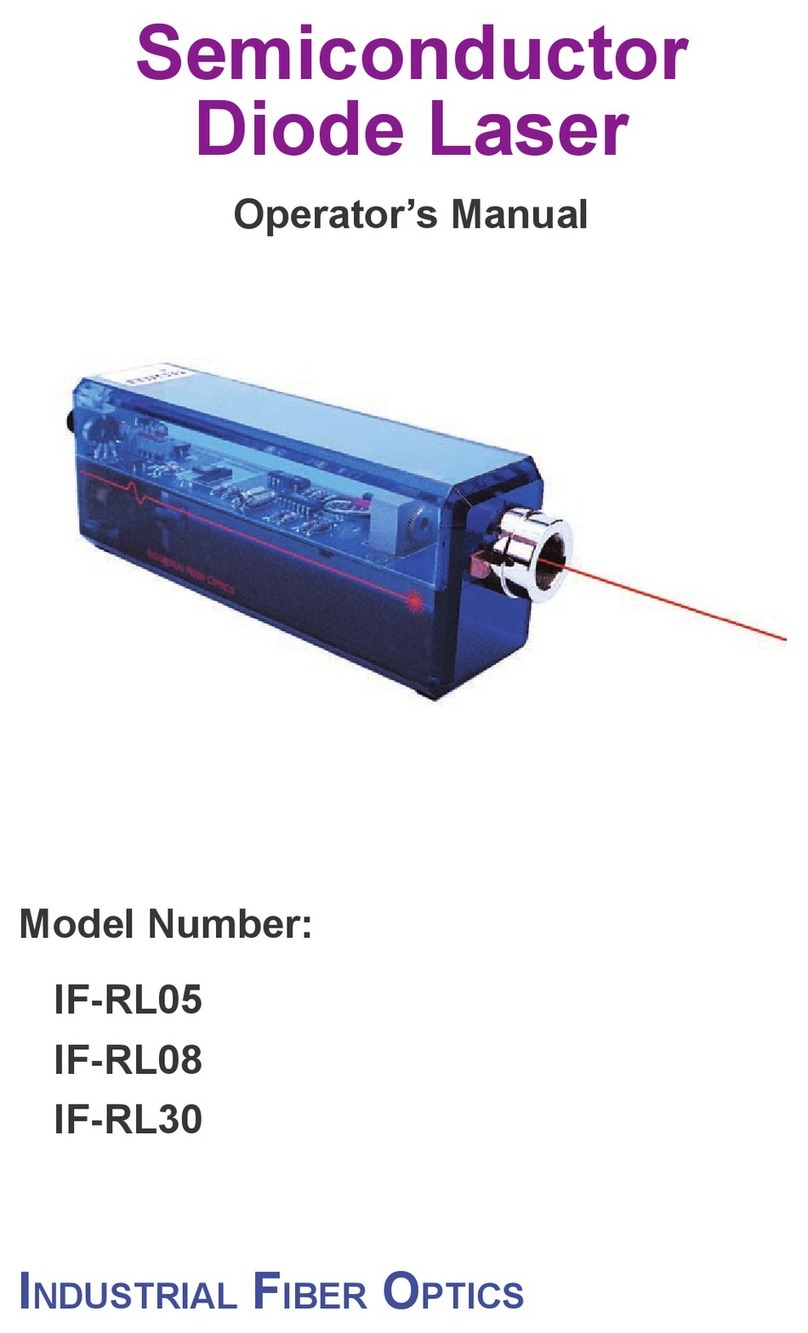
Industrial Fiber Optics
Industrial Fiber Optics IF-RL05 User manual
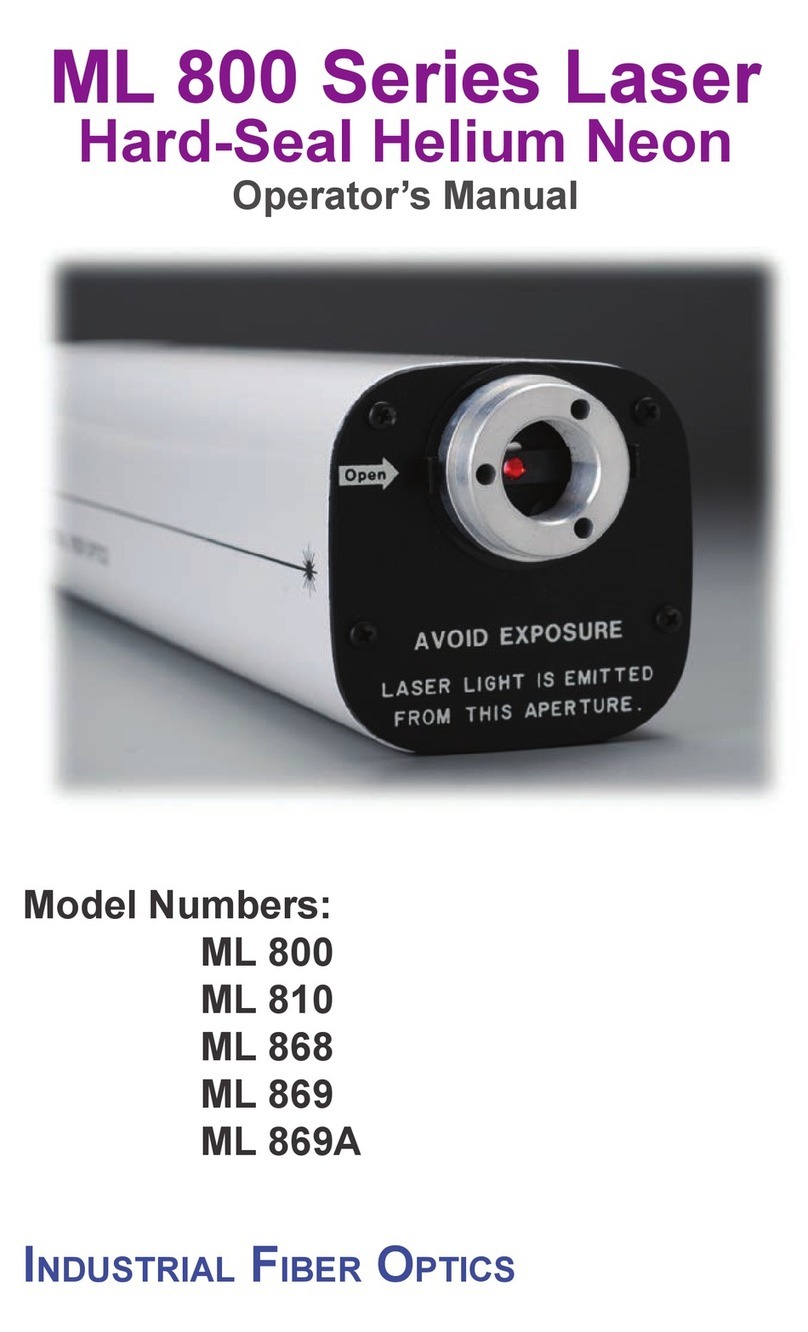
Industrial Fiber Optics
Industrial Fiber Optics ML 800 Series User manual
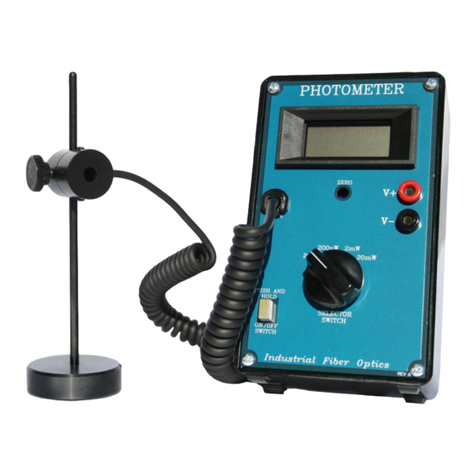
Industrial Fiber Optics
Industrial Fiber Optics IF User manual
